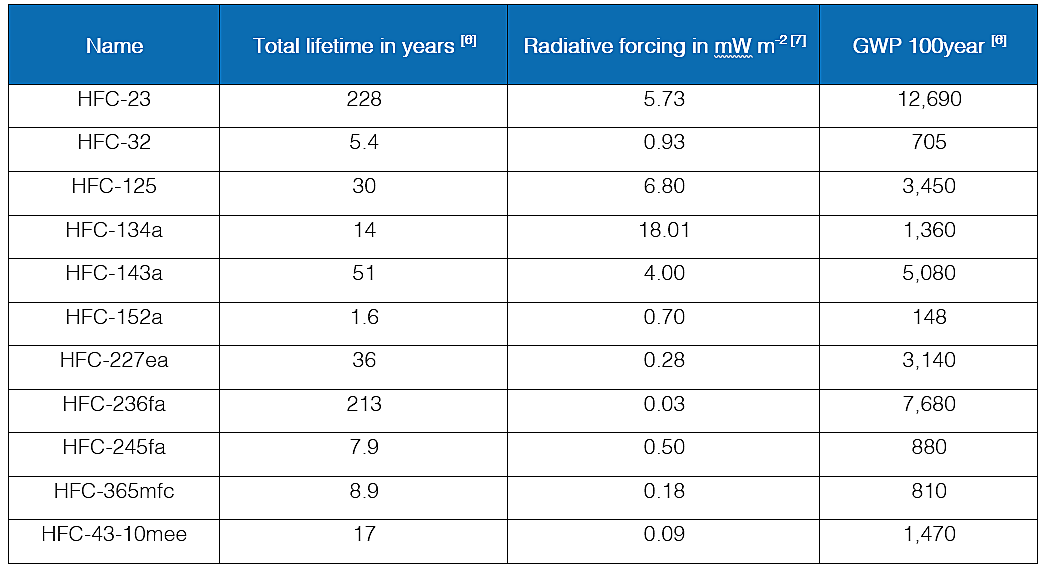Latest figures on HFC impact on climate change
EU reports that hydrofluorocarbons (HFCs) emissions from refrigeration and air conditioning (RAC) have decreased for the fourth consecutive year since 2014. On a global scale, the impact of HFCs on climate change is currently limited: HFCs account for 1% of the radiative forcing from all greenhouse gases. Nevertheless, this figure is expected to increase continuously given the relatively long lifetime of some HFCs.
HFC emissions in the EU
The annual greenhouse gas (GHG) inventory is the official data source for the GHG emissions of the European Union (EU). The EU GHG inventory is prepared on behalf of the European Commission by the European Environment Agency (EEA) and based on the aggregation of the EU Member States’ own inventories under the UNFCCC and the Kyoto Protocol. GHG emissions are reported for the years between 1990 and the current year minus two. Due to this lag in reporting, the 2020 inventory presents figures from 2018.
Fluorinated gases (F-gases), for the most part HFCs, accounted for 2.6% of total GHG emissions in 2018. In value, F-gases emissions amounted to 111 million tonnes CO2 equivalent in 2018. The refrigeration and air conditioning (RAC) sector represents the main source of HFC emissions, accounting for 89% of HFC emissions in EU-27 countries and the United Kingdom. Other sectors include aerosols, foam blowing agents, fire protection, fluorochemical production and solvents.
HFC emissions from RAC have decreased for the fourth consecutive year since 2014. [1] The continued decline is a consequence of the phase down and the system of annual quotas allocated to producers and importers of F-gases according to the EU F-gas Regulation. HFC emissions from RAC decreased by 7% in 2018 in comparison with 2017, a reduction of 6 million tonnes CO2 equivalent. France, Germany, Italy, and the UK were responsible for 55% of HFC emissions from RAC (when considering the EU-27 countries plus the United Kingdom and Iceland).
Adoption of lower GWP HFCs, contribute to the reduction of HFC emissions. For instance, when looking at refrigerants imported in RAC equipment, HFC-32 with a GWP of 675 is on the rise, compared with R410A with a higher GWP of 2088. The most common HFCs reported are HFC-32, HFC-125, HFC-134a and HFC-143a, used pure (such as HFC-32 and HFC-134a) or in mixtures. [2]
On the other hand, illegal trade of HFCs could undermine the EU efforts to reduce HFC emissions. According to the European FluoroCarbons Technical Committee (EFCTC), the illegal trade of HFCs could represent up to 34 million tonnes CO2 equivalent. [3]
Atmospheric measures of HFC concentrations globally
Changes in greenhouse gas concentrations in the atmosphere affect radiative forcing, which is the ability of all greenhouse gases to trap heat in the atmosphere, measured in watts per square metre (W m−2). [4] As one of the five major greenhouse gases, the contribution of CO2 alone to the increase in radiative forcing was 60.6% in 2019, according to the Annual Greenhouse Gas Index (AGGI). [5]
In comparison, the contribution of HFCs to radiative forcing is currently limited. According to the World Meteorological Organization, total radiative forcing from HFCs in 2016 was 0.03 W m-2, accounting for 1.0% of the 3 W m−2 supplied by all long-lived greenhouse gases combined, including CO2, CH4, N2O and halocarbons. Radiative forcing from all halocarbons in 2016 was 0.33 W m−2.[6]
One recent study reviewed the literature data and provided a comprehensive set of calculations to estimate present-day (2014/2019) radiative forcing for 40 of the most common halocarbons (i.e. CFCs, HCFCs, HFCs, halons, HFOs, PFCs, etc.) [7] According to their calculations, the total present-day radiative forcing due to halocarbons is 0.38 [0.33 to 0.43] W m-2. They estimated the present-day radiative forcing due to HFCs to be 0.037 W m-2 (more precisely 37.26 mW m-2). In comparison, they found the present-day radiative forcing due to CO2 to be 2.09 W m-2.
Although currently limited, the contribution of HFCs to climate change is expected to continuously increase in the near future, namely because of the relatively long lifetime of some HFCs, as presented on table 1. For example, HFC-23 has a lifetime of 228 years. [6] In comparison, CH4 emitted today would last 12.4 years in the atmosphere [6], N2O would last 123 years [6] and CO2 would last for thousands of years [8].

Sources:
[1] EU greenhouse gas inventory. https://www.eea.europa.eu/ds_resolveuid/TYURI0AOS7
[2] EEA. Fluorinated greenhouse gases 2019. https://www.eea.europa.eu/ds_resolveuid/1I6JH0G8QK
[3] https://www.fluorocarbons.org/mediaroom/eu-reports-decreasing-hfc-emissions-for-fourth-year/
[4] https://www.epa.gov/climate-indicators/climate-change-indicators-climate-forcing
[5] Butler, J. H., and S. A. Montzka (2020), The NOAA Annual Greenhouse Gas Index (AGGI). https://www.esrl.noaa.gov/gmd/aggi/aggi.html
[6] Scientific assessment of ozone depletion: 2018. World Meteorological Organization. https://ozone.unep.org/science/assessment/sap
[7] Hodnebrog, Ø., et al. "Updated global warming potentials and radiative efficiencies of halocarbons and other weak atmospheric absorbers." Reviews of Geophysics (2020). https://doi.org/10.1029/2019RG000691
[8] https://www.epa.gov/climateleadership/atmospheric-lifetime-and-global-warming-potential-defined
